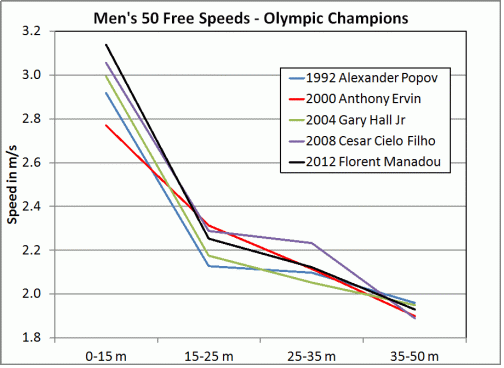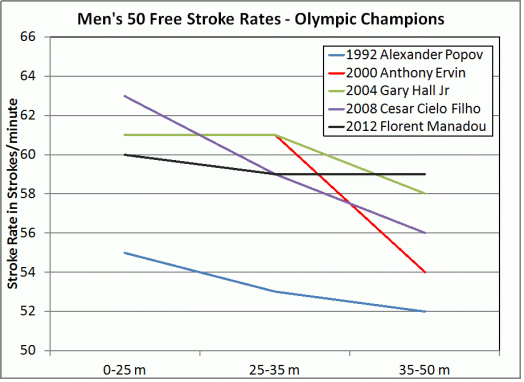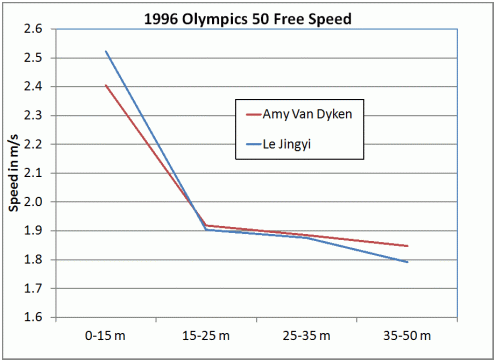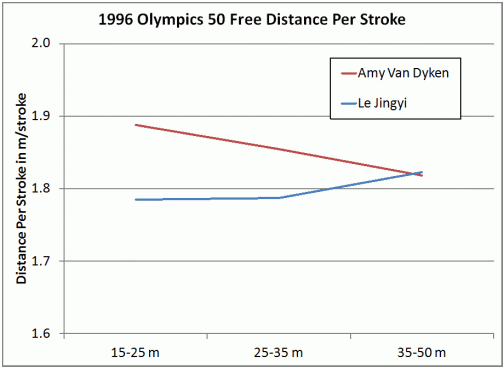I have to admit, it took me a long time to figure out how to analyze the Long Course 50 Freestyle. After all, it’s basically a maximum effort sprint with no turns. That’s not a lot to work with. I actually got my break while I was analyzing underwater speeds (Underwater Kicking: Some Numbers) and I looked at Hill Taylor’s famous 50 Backstroke done completely underwater. I expected his underwater speed to only drop slightly once the effect of the start had passed. But instead I found that his underwater speed started at 2.4 m/s and finished at 1.7 m/s. That’s not a minor drop.
That got me thinking. Do elite 50 Freestylers also drop off significantly over the course of the length? So I started looking at Olympic champions and how they swam their 50s. The results sure surprised me.
(For those that are interesting in these things, I measured all splits and stroke rates on YouTube race videos, and adjusted for the actual frame rates of the videos. All times were measured at the head, except the 50m time. In order to take into account the hand touch at the end, I shortened the last leg of the 50 by 0.7m for men, and 0.6m for women.)
Men’s 50 Free
The figure below shows the race speeds of 5 men’s winning Olympic races. I measured times at the 15m mark, 25m mark, 35m mark and at the end. Note that Gary Hall Jr and Anthony Ervin tied for the win in 2000, but the view of Ervin was slightly better on the video so I used his race.
The thing that stands out to me is how the first 15 m are getting increasingly fast over the years. The range of speeds over the first 15m are from 2.8 m/s (2000) to 3.15 m/s (2012). That’s a speed increase of over 12% over the years.
The next thing that I notice is that the true swimming speeds – I ignore the first 15m due to the effect of the start – drop off considerably over the course of the race. The average speed for the 15-25m part of the race was 2.23 m/s, while the average speed of the 35-50m portion was 1.93 m/s: a difference of roughly 15%. This shows that in all 5 of these winning Olympic races, they slowed down considerably at the end of the race. Even more interesting to me is that they all slowed down to roughly the same speed. About 1.9 m/s.
I then looked at the stroke rates for each of these swims.
My first thought on seeing this chart is that there are huge variations in stroke rates in these races. While stroke variations between swimmers is completely understandable, these are Olympic champions! But what really intrigued me is the significantly lower stroke rate of the phenomenal Alexander Popov. His stroke rate is roughly 10% below the others.
The next thing we can see is the significant stroke rate drop over the course of the race for all but Manadou. Cielo dropped from 63 to 56. Ervin from 61 to 54. Even Popov dropped from 55 to 52. Since they won their races, they clearly didn’t fall apart. Apparently, just about everybody has a significant stroke rate drop in this race.
And finally, since I have speeds and stroke rates, I can calculate distance per stroke.
As expected, we can immediately see that Popov’s low stroke rate and high speeds produced significantly higher distance per stroke than the others. But notice that with all 5 swimmers, the 35-50m distance per stroke is lower than the 15-25m distance per stroke, with some of them lower by more than 10%. All signs seem to point to a minor collapse.
Women’s 50 Free
I performed the same analysis with the Women’s Olympic 50 Free. The years are slightly different as not all of the videos were useful in terms of timing at key points in the race.
My first impression is the same as with the Men’s 50 Free. We can see that the 0-15m speeds inexorably go up as the years go by. The range is from the 1996 first-15m speed of 2.4 m/s to the 2012 speed of over 2.7 m/s. Again, a significant increase in opening speed. It will be interesting to see when this increase in speed tapers off.
The women differ from the men, however, in that the women’s races all show surprisingly consistent speeds at every part of the race after the 0-15m segment. They all drop by roughly the same amount at each split. And just as with the men, the women all finish the race at roughly the same speed. Just under 1.8 m/s.
In other words, everyone seems to be using the same race strategy.
Women’s stroke rates are significantly different than the men. While the men generally dropped their stroke rate thoughout the race, the women tended to level off. And then we have the unique case of Kromowidjojo in 2012 where she significantly increased her stroke rate for the last 15 m.
This would tend to tell me that the women were swimming a more controlled race than the men.
Once again, we notice that even with distance per stroke, the women have much more similar races profiles than the men. However, the women also appear to experience a minor collapse during the race.
1996 – Amy Van Dyken vs Le Jingyi
 During the course of my research I came across one fascinating race. At the 1996 Olympics, China’s Le Jingyi faced off against the US’s Amy Van Dyken. In this race, Jingyi took off at the start, well ahead of Van Dyken. And it stayed that way until the last few metres when Van Dyken surged ahead to win by 0.03 seconds. See the race here.
During the course of my research I came across one fascinating race. At the 1996 Olympics, China’s Le Jingyi faced off against the US’s Amy Van Dyken. In this race, Jingyi took off at the start, well ahead of Van Dyken. And it stayed that way until the last few metres when Van Dyken surged ahead to win by 0.03 seconds. See the race here.
So I decided to analyze this race using the above methods. Here’s what I found.
In the video we can see Jingyi blast out to an immediate lead, and then hold that lead one until the dying metres. The speed chart certainly reflects that. But notice in the stroke rate chart that Van Dyken held a constant stroke rate of 60 for the whole race, while Jingyi’s stroke rate fell appreciably in the last 15 m.
We can also see that Van Dyken didn’t really surge ahead at the end. She was still slowing down. Jingyi just slowed down in the closing metres far more than Van Dyken was slowing down. In other words, Jingyi died in the last 5 m.
Not surprisingly, the distance per stroke chart shows a slow and steady drop for Van Dyken, while Jingyi’s distance per stroke increases at the end. To me it looks like Jingyi lost the race by taking it out too hard, and had to drop her stroke rate to keep her power up at the end in an attempt to hold off Van Dyken. Van Dyken was able to take advantage of that with her far steadier stroke rate and speed for the whole 50 m.
This race was a complete contrast in styles.
Summary
To me, a key point from the above analysis is that these Olympic champions are all fading significantly during their 50 m race. Rather than holding a steady pace, this sprint race appears to be all about who dies the least. It seems that it’s impossible to sprint the whole 50 m.
To illustrate this, we can look at how swimmers swim other races. If this was a 400 and the swimmers faded this badly over the course of the race, we would consider their race strategies to be seriously flawed.
Let’s take the 2012 Women’s 400 Free race as an example. In this race, Camille Muffat’s last three 100s vary by less than 1 second, and in fact her last 100 was faster than the previous two. To put that in perspective, her last three 100s varied by less than 1.5%. (If I take into account the lack of a flip turn in the last 100, the variation would be less than 1%). In her 50, Jingyi dropped over 6% from her 15-25m speed to her 35-50m speed. Van Dyken dropped just under 4% in her race.
Should we be swimming the 50 differently?
We’ve seen that holding a top sprint speed for 50 metres is impossible. Nobody is coming close to holding their speed the whole way. So perhaps 50s should be raced by holding back a little in the opening 25m, and then keeping a higher, steadier speed until the end.
I guess we won’t know until somebody is brave enough to train for this, and then try it in a big race.













I think the elite swimmers do try to not slow down. I think they do hold back and don’t press it until past the 25
Maybe consider the speed of the underwater kick these swimmers have and how that might show such a high initial top speed. As our sport matures it is selecting kickers not pullers. Just as nature has selected for kickers not pullers in the aquatic world of nature.
[to your point about Hill Taylor, if the rules were different, as in ’88 or ’92, he would have been the Olympic Champion. The rules have a lot to do with who is or isn’t champion. The rules benefit some while harming others]
Was Gary Hall Jr.’s speed at the end of 100m that much faster than his dad’s; or Jim Montgomery? (I understand this is an article about the 50, my point is that time improvements have come from starts, turns and kicking not so much swimming on top of the water).
I agree that stroke rate decreases greatly over the course of a 50m. In coaching sprinters, I find that this is due largely to a slower recovery not a slower pull. The muscle group for recovering in freestyle is much smaller than the pulling group. Sprinters should focus on finishing their stroke and quickly catching again. It seems that the top sprinters are using a much simpler recovery to accomplish this.
I think sprinters (and swimmers in general) should never do fingertip drag or armpit drill. The classic high elbow-low hand recovery is an overly articulated movement. This technical philosophy only sees getting the hand from finish to catch as a straight line pendulum swing. While this might be great for a machine, it doesn’t take into account biomechanical efficiency.
This is why I believe sprinters arms are getting much straighter. And truth be told, even distance swimmers have a much simpler recovery than in the past.
NIce post. Thanks for the read.
As always a very interesting analysis Rick. I wonder if somebody has analyzed Olympic 100m land sprints in a similar fashion (e.g. starting pace, middle pacing, distance per stride, etc).
Thanks Jim, Actually the best analog in running would be the 200m sprint. The timing is almost exactly the same, about 20-21 seconds, and so the use of energy systems and fibre types would be almost exactly the same. About half of the race would be anaerobic, and the rest by the decaying anaerobic and the fresh aerobic system. That would certainly be an interesting analysis.
Great analysis!!! Thanks for sharing!
Dear rick,
Thanks for this interesting view on swimming kinematics. I have some queries: could you share with us the links of the videos you used if you still have them? I have looked at some and find it difficult sometimes to see when the swimmers cross some marks…
Thanks Kermit,
I really wish I did still have a record of those videos. And you’re right in that it can be very difficult to see when they pass those marks.
For that reason, I measured each video 10 times and use the median time. And I tried to find 3 different videos for each race (not always possible) so that I was looking at the race from different angles. This still means that there is probably a large error bar for each measurement, but the number of samples will help to reduce that somewhat. And in case you’re wondering, yes, this took a long time. I actually wanted to continue back to the 70s, but the lack of good videos made that impossible to do with any confidence.
Thanks for this really quick answer. To be honest I am currently doing a little research project on the 50 m freestyle and your data are interesting to me. Would you mind sharing with me the raw data?(with error bars if possible)
I have some videos of the race but I haven’t found 3 per races… sometimes I have trouble to find one…For the most recents, I can go further as the quality of the images are way nicer. Would you like to discuss this in private? You can email me at nakedfluiddynamics@icloud.com
This is fascinating. Thank you for sharing this.
Something that I find particularly interesting is that I heard Tony Ervin was the fastest in surface swimming in 2012 (and probably in 2016). He has said before that he doesn’t have any specific technique, he’s just feeling for acceleration, whereas other people are more mechanical. Looking at your analysis here, each one of the 3 mens graphs show Ervin to be the most different – linear decrease in speed, steepest drop-off in stroke rate, increasing distance per stroke.
You’re obviously providing this analysis for free, so I don’t want to ask you to do more work than you want, but would you be willing or interested in doing an update or a part 2? One which which might include Ervin’s 2012 and 2016 performances, as well as Dressel’s 2019 performance?
As a side note, although they start from a stand-still, it might be interesting to compare the back-half of 200m track sprinters to 50 meter freestylers.
Hi Ian. Thanks for the post!
That’s probably a great idea for me to look at Ervin specifically, although I have no idea when I’ll have time to do so. 2016 would be challenging to analyze, especially with the circulating currents that were working against him! With the fall-off at the end of the race, a complete analysis of everyone’s back end speed would be fascinating.
As for 200 m track versus 50 m swim, that’s an intriguing thought. Far less drag going through air which might change the energetics and speed strategy. When you burn out in the pool, the speed change can be drastic.